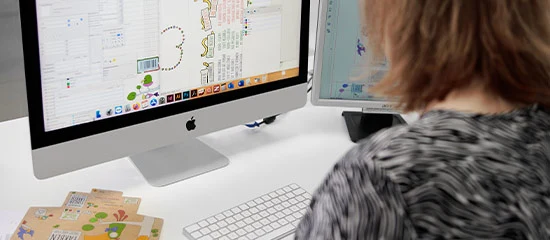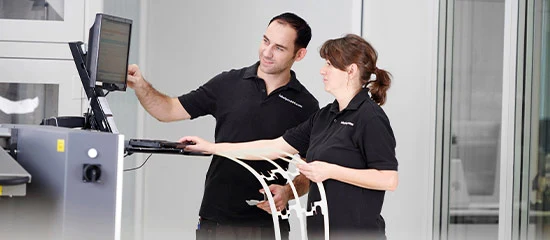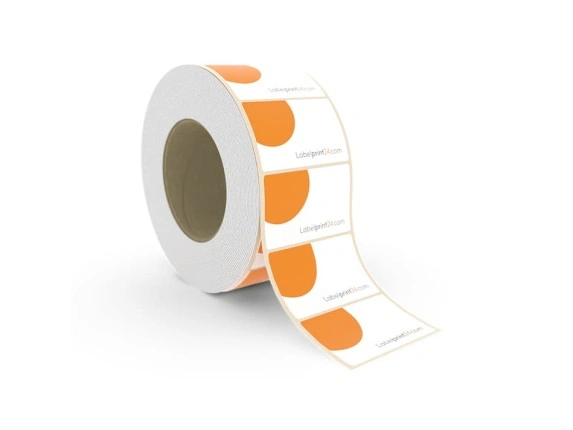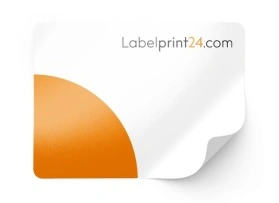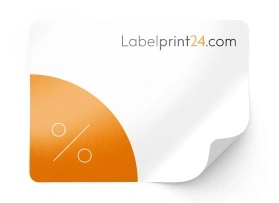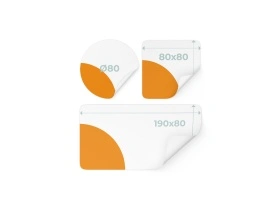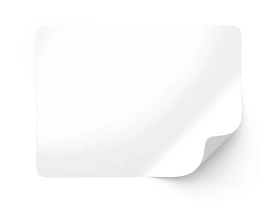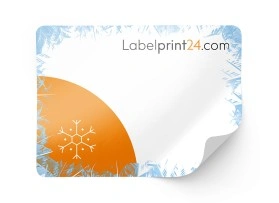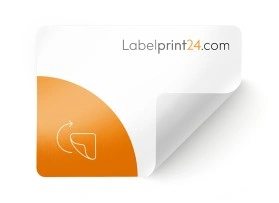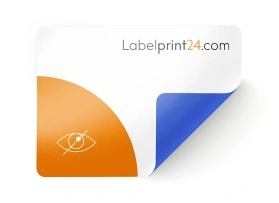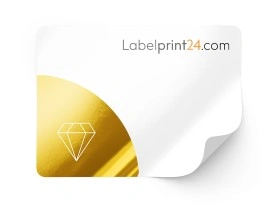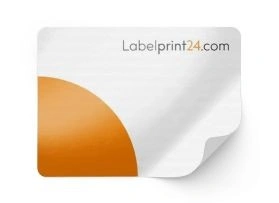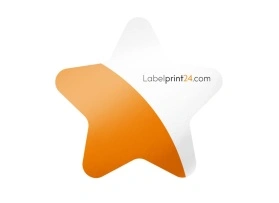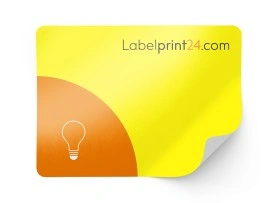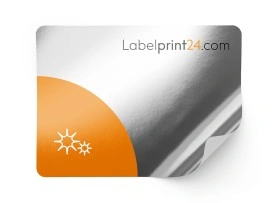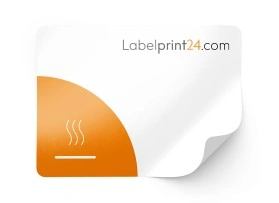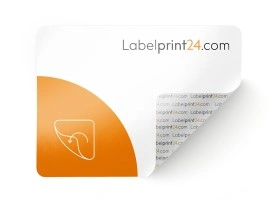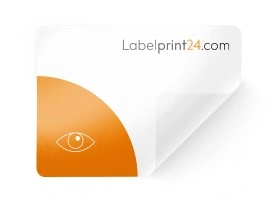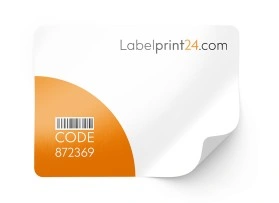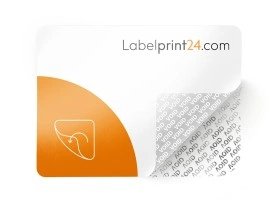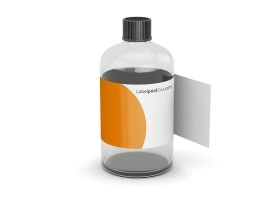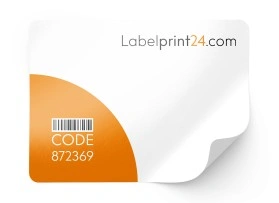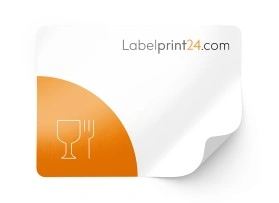Printed labels
Looking for high-quality printed labels? Whether you need opaque, numbered, or metallic labels, or labels compatible with thermal printing for frozen goods - printed labels from Labelprint24.com offer professional and personalized solutions to meet all your product marking requirements. Get your custom labels quickly and enjoy complimentary shipping with Labelprint24. With our state-of-the-art manufacturing you can experience superior quality with vinyl sticker printing using the latest technology.
- Fast production and free delivery
- Cutting-edge of manufacturing for higher quality
- Wide range of labels accessories
Discover our wide range of high-quality customised labels !
- Production TimeFrom 48hr
- MaterialFilm / Paper
- Size100% customizable
- Finish OptionsFilm / Varnish
Select kind of product
What are printed labels?
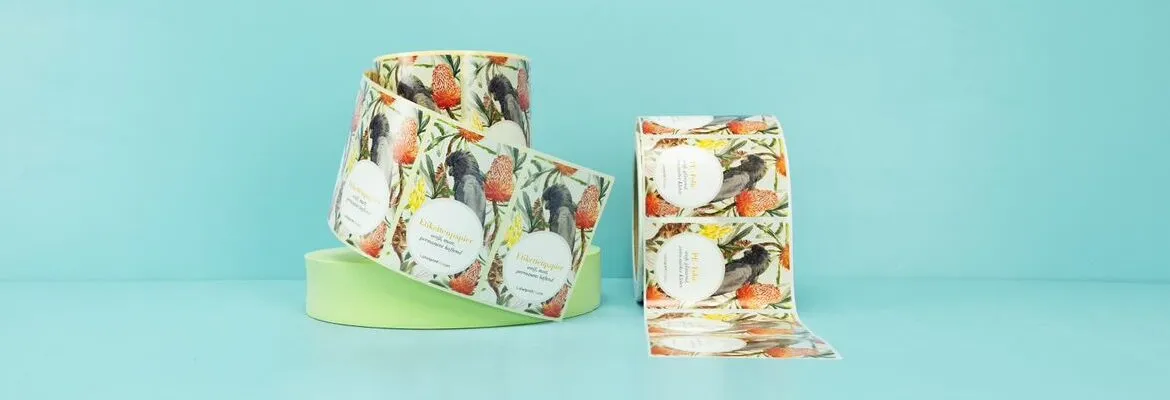
Printed labels, also known as adhesive labels on a roll, are your solution for efficient labelling. They are often referred to as roll labels, bottle labels, or self-adhesive labels, these printed sticky labels are essential for packaging and product identification. Their applications span the food and beverage, chemical, and cosmetics industries, among others.
Depending on their intended use, printed labels can be designed to be short-term or durable. They may need to be food-safe, water-resistant, scratch-resistant, UV-resistant, and chemical-resistant. Innovative printed labels ensure that they perform effectively under various conditions, catering to diverse labelling needs.
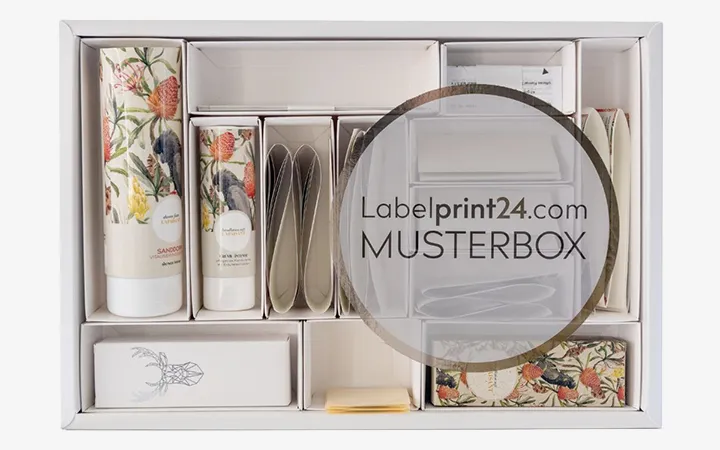
Patterns made to measure. Simply order online.
The sample box from Labelprint24 offers you an exclusive selection of products, printed and finished in our company design. We will refund the full purchase price of the sample box in the form of a voucher if you decide to place an order with Labelprint24. The voucher is of course valid for all products in our webshop.
In this box you will find samples of single and multi-layer roll labels, folding cartons, laminate tubes and package inserts.
These printed label stickers are compatible with both manual and automatic label dispensers, featuring a rotating dispensing system that enhances labelling speed. With the right printed labels on rolls, businesses can achieve secure adhesion and economic efficiency—key factors in industrial labelling processes.
At Labelprint24, we offer a wide range of printed labels, including personalised labels, available in all common formats and materials. Explore our collection of printed labels UK, where quality and efficiency are our top priorities.
Print data for your labels
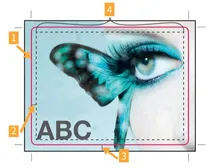
Essentials: roller core & carrier material
Printed roll labels consist of two essential components: the roll itself, which holds the labels, and the material that serves as the base for the printed labels. Whether you are looking for personalised labels, custom labels, or high-quality printed sticker labels, understanding these components is key to achieving effective labelling solutions.
Winding on roller core
As the name implies, printed stickers produced as roll labels are wound onto a roll after printing. This process requires a robust roll core made of thick cardboard, with a diameter that matches the customer's existing label dispenser. While any roll core diameter is theoretically possible, standard diameters of 26 mm, 40 mm, 50 mm, and 76 mm are commonly used in practice.
When rewinding onto the designated roll core, it is crucial to maintain the correct winding direction. This ensures that the printed labels are dispensed properly onto the products that need labelling at the customer's premises. The printed labels on the roll are always wound in a way that places them either on the inside or outside of the label roll, facilitating easy access and application.
Carrier material
The carrier material for printed labels remains in place until the label is removed and applied after printing. This material can consist of thin glassine, kraft paper, or a special film designed for high-performance labelling machines. Many printed labels feature a silicone release liner on the adhesive side of the roll label, allowing for easy removal of the printed label from the backing material when needed.
Once the labelling process is complete, the liner tape is typically disposed of and can be recycled, making it a practical choice for those utilizing personalised labels or custom labels in their operations.
Applications of printed labels UK
There are many diverse applications of printed sticky labels. The types of printed labels are as varied as their applications. Labels can range from inventory labels used in the office to operating labels on machines and systems. Each area of application presents specific requirements for the printed labels, including resistance to moisture, temperature variations, chemicals, uneven or oily surfaces, sunlight exposure, and high abrasion.
Printed labels are essential in numerous applications, such as:
- Work safety,
- Hazardous substance labelling,
- Information management,
- Tamper protection,
- Safety labelling, product labelling or in the office and administration.
Printed labels are essential in numerous applications, such as:
Typical areas of application for printed roll labels
The applications for printed labels are vast and varied. Here are some examples:
- Labelling food with food labels
- Numbered barcode labels in the transport and logistics industry
- Transport stickers for labelling containers with chemicals
- Weather-resistant film labels for the chemical and automotive industries
- Labelling of technical components
- High-gloss labels and transparent stickers for cosmetics
This list of applications for printed sticker labels could go on indefinitely. Interestingly, almost every industry has unique requirements for the roll labels they use, which must be taken into account during the printing labels' production process.
Examples of industry-specific labelling requirements
- Labelling with food labels often occurs under challenging conditions, such as in wet or greasy environments and at freezing temperatures. In the regulated food industry, numerous legal requirements must be observed, including REACH conformity, food labelling regulations, and the Food Information Regulation Act. It is crucial to ensure that there is minimal or no migration of microscopic adhesive and labelling material components from the food labels into the food itself.
- For products used in the chemical industry, approval according to ‘British Standard 5609 Section 2’ is mandatory. This standard ensures that printed labels can withstand storage in salty seawater for three months without detaching from the labelled container during maritime transport.
Given these unique challenges, various industry-specific factors must be considered, significantly impacting the materials chosen for printed labels. Additionally, the decision regarding the label printing production process is influenced by the order volume, intended use, and requirements for further processing.
For more information about printed labels for industrial apllications and personalised sticker labels, read more about our offerings.
Printed labels fabric
Your printed labels fabric is an important feature to consider. Whether in roll or sheet format, printed self-adhesive labels fundamentally consist of four components: a backing material, pressure-sensitive adhesive, face material, and printing ink. Printing professionals refer to this construction as an adhesive bond. Additionally, a transparent varnish and/or a metallic film can be applied for enhanced aesthetics or durability.
After printing, roll labels are wound onto a cardboard roll core in the quantity specified by the customer. The face material of the labels, which displays the printed image, can be made from either label paper or label film, offering versatility for various applications.
Label paper
Printed labels made from label paper are the most affordable option available. However, they are primarily suitable for short-term outdoor use or for indoor applications in areas adequately protected from moisture, wind, and weather conditions. There is a variety of label paper types with different grammages, surfaces, and structures. An optional blue back coating can enhance the opacity of the label paper.
For the pharmaceutical sector, a specialized label paper with lower thickness is designed for flexibility, enabling it to conform perfectly to highly curved surfaces, such as ampoules.
Our Material Properties of Paper Labels at a glance:
- Matt paper, permanent adhesive
- Matt paper, removable adhesive
- Matt paper, permanent adhesive, suitable for deep-freezing
- Matt paper, permanent adhesive, opaque for opaque labels
- Glossy paper, permanent adhesive
Calculate now as labels on a roll for your application:
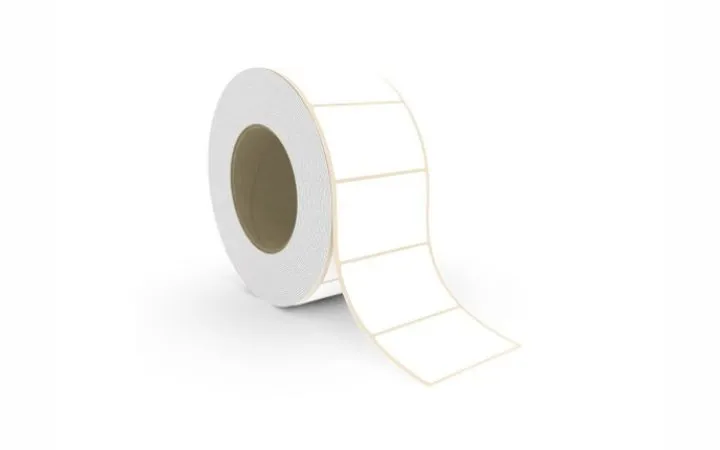
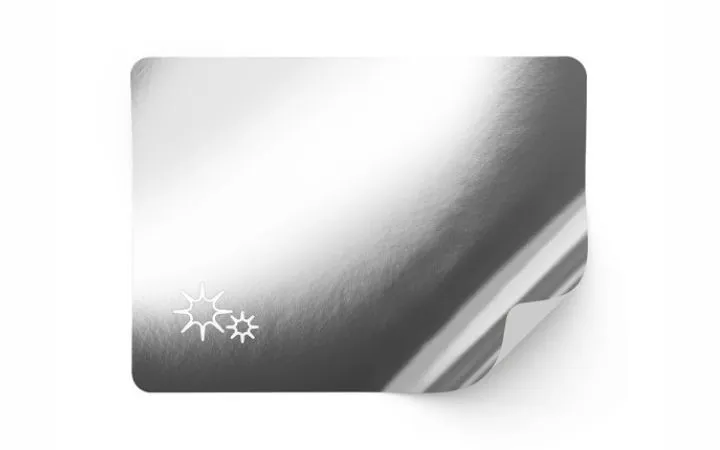
Metallised paper labels
Printed labels made from metallised paper feature a layer of fine, laminated aluminium foil that is applied to the paper surface during production. Labels created with this metallic paper composite exhibit a striking metallic sheen in shades such as silver or gold, depending on your specific requirements. This paper is particularly suitable for achieving a high-quality, metal-like effect, making it an excellent choice for cosmetic labels.
Our material properties of metallised paper labels at a glance:
- Metallised paper, SILVER glossy, permanent adhesive
- Metallised paper, GOLD glossy, permanent adhesive
Calculate now as printed labels for your application:
Luminescent-coloured paper labels
Printed labels made from fluorescent paper, often referred to as neon or fluorescent color paper, are designed for high visibility and are commonly used as price labels. The vibrant yellow, red, orange, or green colors are produced by color pigments that are applied to the base label paper during the manufacturing process.
Our material properties of fluorescent papers at a glance:
- Luminescent-coloured paper, GREEN, permanent adhesive
- Luminescent-coloured paper, RED, permanent adhesive
- Luminescent-coloured paper, ORANGE, permanent adhesive
- Luminescent-coloured paper, YELLOW, permanent adhesive
Calculate now as printed labels for your application:
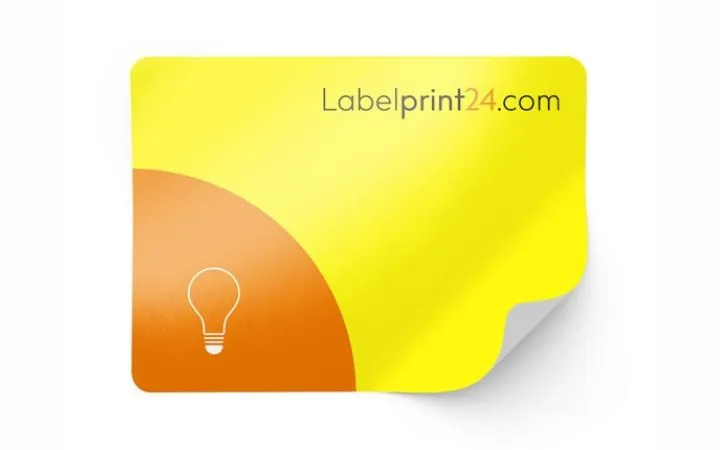
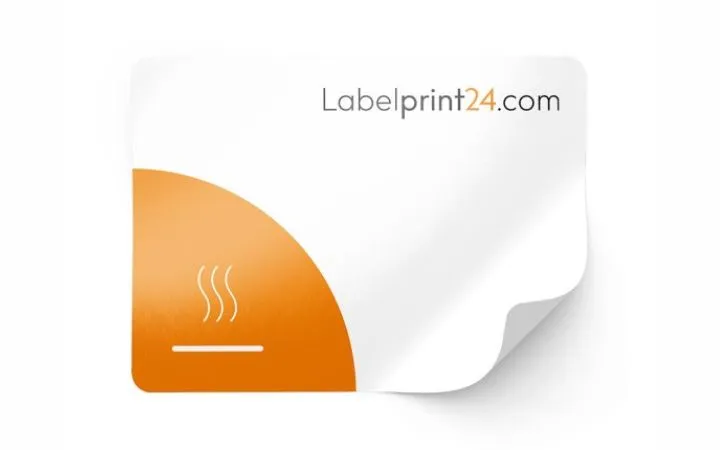
Thermal paper labels
One of the most common applications for printed labels is found in supermarkets, where roll labels made from thermal paper are utilized for direct printing at self-service kiosks. Scales equipped with integrated label printers effortlessly produce labels that function as receipts, displaying an EAN or barcode, weight, and price i.e. data that’s compiled just before printing. The typical black colouring of the printed image on thermal paper labels is made possible by a special reaction ink, the thermal coating, which is applied to the base label paper by the paper manufacturer.
When creating roll labels from thermal paper for direct printing, it’s crucial to incorporate a protective layer on the surface - this layer ensures that the reaction color remains inactive during the printing process at the label printing facility.
Our material properties of printed thermal paper labels at a glance:
- Thermal Eco paper white, matt, permanent adhesive - for standard applications
- Thermal Top paper white, matt, permanent adhesive, with protective coating for long-term use
- Thermal top paper white, matt, permanent adhesive, with protective coating for long-term use, suitable for deep-freezing
Calculate now as printed labels for your application:
Label film labels
Printed labels are increasingly being crafted from label films, such as PE, PP, and PVC, which offer several benefits over traditional paper labels. One of the key advantages of these printed film labels is their suitability for outdoor use without compromising quality. These labels are exceptionally durable, exhibiting excellent resistance to environmental factors such as moisture, acids, chemicals, UV radiation, and greasy substances.
Moreover, you can a transparant effect with plastic film labels. These transparent labels are used for labelling cosmetics and drugstore products, among other things. Here, it appears as though the information is printed directly onto the product, and the ‘invisible’ printed label helps give your product a premium look.
Our material properties of the printed label films at a glance:
- PE film white, glossy, permanent adhesive
- PE film white, glossy, extra-permanent adhesive
- PE film white, matt, permanent adhesive
- PP film white, glossy, permanent adhesive
- PP film white, glossy, removable adhesive
- PP film white, glossy, permanent adhesive, suitable for deep-freezing
- PP film white, matt, permanent adhesive
- PP film white, matt, removable adhesive
- PVC film white, glossy, permanent adhesive
Calculate now as printed labels for your application:
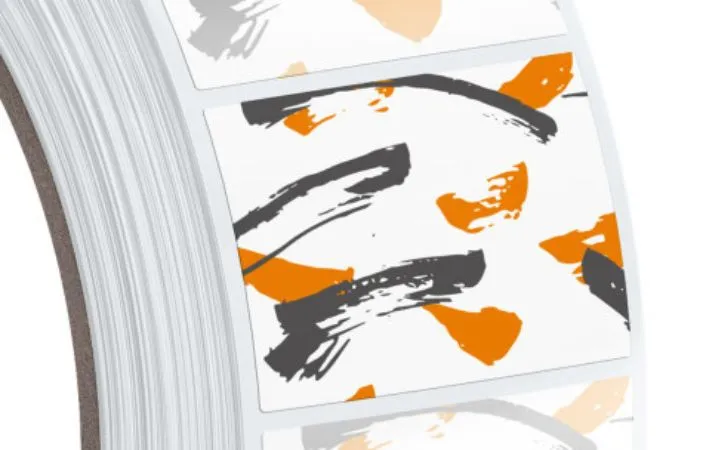

Security labels
Security labels are crafted from a combination of paper, film, ink, and permanent adhesive. Utilizing a hot-melt adhesive, these sealing labels bond securely to critical surfaces, including steel, glass, damp plastic, and various building materials. Security labels play a vital role in detecting tampering attempts, sealing high-quality products, and marking property. They are an economical and efficient solution for enhancing product security, making them an indispensable component in many industries.
Material Options for Security Labels:
- VOID PET film, white, transparent
- VOID PET film, with hologram
- Security label made of paper, opaque, peelable and self-destructing
Calculate your requirements now for printed labels suitable for your application:
For businesses seeking reliable printed sticky labels, our collection includes personalised sticker labels designed to meet diverse security and branding needs. Explore our offerings today to find the ideal printed material labels that cater to your specifications.
Printing process for printed labels
Printed labels on rolls can be produced using either digital printing systems or the conventional flexographic printing process. Both methods offer excellent print quality, giving you flexibility in your labeling options. In our online calculator, you can easily compare these technologies to find the best fit for your needs.
Factors Influencing the Optimal Printing Process for Labels:
- Label Order Volume: Small and medium runs benefit from digital printing, while flexo printing is more cost-effective for large quantities.
- Label Material: The choice of material can influence which printing method works best.
- Requirements for Migration: Specific labeling applications may require particular materials to minimize migration issues.
- Additional Functions of the Labels: Features like barcodes or QR codes may influence the choice of printing technology.
- Requirements for Personalization: With our digital printing systems, we can personalise roll labels with individual data, such as consecutive numbers, codes, or changing print motifs.
Digital printing offers a cost-effective solution for small to medium runs of printed labels, while flexographic printing is ideal for larger print volumes. Additionally, flexo and offset printing provide a wider selection of materials. For industries that require labeling for products with indirect food contact, we have a variety of suitable printed material labels available, including food labels.
Adhesive roll labels
You can already select which materials, adhesives, colours and finishes are suitable for you in the calculation. Flexographic printing is the best printing process for high-quality adhesive roll labels with medium and large print runs. This is where it really comes into its own:
- Incredible brilliance and authenticity of the colours!
- Particularly favourable prices for large print runs!
We offer a wide range of conventional adhesive labels on rolls in all formats, including: rectangular, round, oval, large and small. Your printed roll labels can be customized to be self-adhesive, removable, or equipped with a suitable deep-freeze adhesive, depending on your specific needs. Additionally, we can enhance your roll labels with hot or cold foil finishes as required.
Depending on the configuration, our printed labels can be utilized both indoors and outdoors - thanks to our UV varnish, which provides exceptional weather and UV resistance. We supply your custom-printed roll labels in the desired quantity, wound on durable cardboard roll cores in standard core diameters ranging from 26 to 76 mm.
Flexographic printing: a versatile solution for printed labels
Flexographic printing is a so-called letterpress process in which the ink is transferred to the substrate, which runs between the printing plate and the impression cylinder, via a raised, flexible printing plate (cliché). Compared to other printing processes, flexographic printing has the invaluable advantage that a wide variety of materials can be printed on, from simple paper to laminates, from plastic film to cardboard - no other industrial printing process has a similarly wide range. This capability makes it unrivaled among industrial printing processes, offering an extensive variety of options for printed labels.
Flexographic printing of roll labels is particularly renowned for its brilliance and diversity in color. Using the basic colors of cyan, magenta, yellow, and black (CMYK), this process allows for an unlimited array of color mixtures and screen areas, ensuring that your custom labels stand out.
Moreover, flexographic printing adheres to high standards of environmental friendliness, making it a sustainable choice for businesses looking to produce high-quality printed labels that are also eco-conscious.
Flexo vs. digital printing
At Labelprint24, we specialize in printed labels using both conventional and digital printing methods. We print your roll labels using conventional printing in all special colours from the so-called HKS, metallic colours or Pantone palette. These special colours are already mixed and have a bright, intense quality with rich solid areas. For custom labels, our flexographic printing provides a wide choice and remarkable flexibility, as there are almost no restrictions regarding the choice of materials to be printed on - any paper weight, the so-called grammage, any surface, any quality, even PP, PE and PVC film can be printed effectively. Due to the large selection of material variants and paper thicknesses, flexographic printing of roll labels is more variable than digital printing.
However, digital printing shines in its ability to produce personalised sticker labels. Unlike flexographic printing, it doesn't require elastic printing forms, which means each roll label can be printed (personalised) differently.
As a general rule, the smaller the print run, the more economical digital printing of adhesive labels on rolls is compared to conventional printing. From print runs of 50,000 - 100,000 pieces, flexographic printing is usually more cost-effective. Thanks to the use of innovative technology and state-of-the-art digital printing systems, such as the UV inkjet machines installed at Labelprint24, you can have even medium-sized runs of roll labels produced by us just as cheaply and in super quality.
The choice of printing process (digital or conventional) for the production of your personalised sticker labels is always a question of the print run, the quality, the planned production date and, last but not least, the price. We will be happy to help you decide between flexographic or digital vinyl sticker printing. Simply use our free online calculator, or contact our experienced specialists who are more than happy to advise.
Direct thermal printing vs. thermal transfer printing
Thermal printing processes, which are temperature-dependent, always rely on a hot print head, a thermal comb with dots (special semiconductor resistors), and a specially coated, temperature-sensitive material. There are two widely used printing methods for thermal printers: direct thermal printing and thermal transfer printing.
Direct Thermal Printing:
In direct thermal printing, the print head heats a thermosensitive material, causing the color of the thermal paper to change at the heated points. This technique reveals black numbers, letters, and/or images. While the print quality may not be as high, this straightforward approach is cost-effective and does not require additional consumables, such as color ribbons. However, it's important to note that the printed information may fade over time due to exposure to light and heat.
Thermal Transfer Printing:
Thermal transfer printing is a more complex process that produces a superior color print image. This technology utilizes a color ribbon, where the heat from the print head transfers color from the thermal transfer ribbon to the material being printed. It permits printing on any standard labeling material, resulting in significantly better print quality and resolution. The materials produced using thermal transfer printing are also more durable, making them suitable for various applications.
As labeling specialists, we understand the needs of our customers and offer perfectly matched labeling accessories, such as hand label dispensers and table label dispensers in various designs. We are pleased to provide quantity discounts on our diverse range of label dispensers within our graduated pricing structure.
Whether you need printed labels for product identification, personalised labels for branding, or printed sticky labels for promotions, our thermal printing solutions can accommodate your requirements effectively.
Products and further processing
Writable labels, often referred to as blank labels, are ideal for users who wish to print their own information. These labels are commonly utilized in pharmacies for labeling products with content information or expiry dates, and they are also popular in food industries for items like jams and preserves. To effectively print on these printed labels, suitable thermal tape and printers are essential.
If you want to have labels printed, you can do this with the help of our calculator.
Whether you need printed sticky labels, personalised labels, or any other type of printed material labels, we are here to assist you in finding the right solution for your labeling projects.
High-quality thermal transfer ribbons for every printing need
Whether you’re using a desktop or industrial printer, our selection of thermal transfer ribbons offers the perfect quality for nearly every common printer model and substrate type. Our thermal transfer ribbons from Labelprint24 are designed for use with both rough and smooth paper, along with various plastic surfaces, ensuring they are gentle on the print head - while offering a wide range of design options thanks to an extensive selection of colors.
Thermal transfer ribbons are essential consumables for thermal transfer printers, which utilize this technology to effectively print all types of printed labels, beit custom labels or printed material labels. Their special printing units use thermal transfer to transfer the dyes transported on the thermal transfer ribbon to paper, film or other substrates. By heating the carrier material, the liquid colour is then applied to the substrate with the help of a roller.
Applications for Thermal Transfer Ribbons and Printers:
Thermal transfer ribbons and thermal printers have diverse applications across various sectors, including retail, public authorities, and healthcare. Common uses include producing tickets, parking permits, and textile labels. Wax thermal transfer ribbons are often used for logistics labels, such as shipping labels and pallet stickers.
Composition of Thermal Transfer Ribbons:
Thermal transfer ribbons consist of a 3.5 to 6 µ (thousandths of a millimetre) thick polyester film, which is coated on one side with a 2 to 4 µ thick layer of ink. Different proportions of waxes and synthetic resins as well as colour pigments, usually carbon particles (soot), to achieve vibrant colors suitable for printed material labels
Explore our range of label stickers and find the ideal thermal transfer ribbons for your labeling needs today!
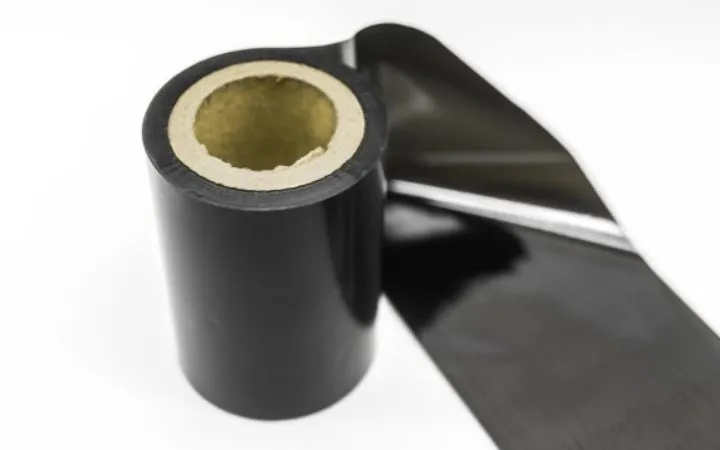
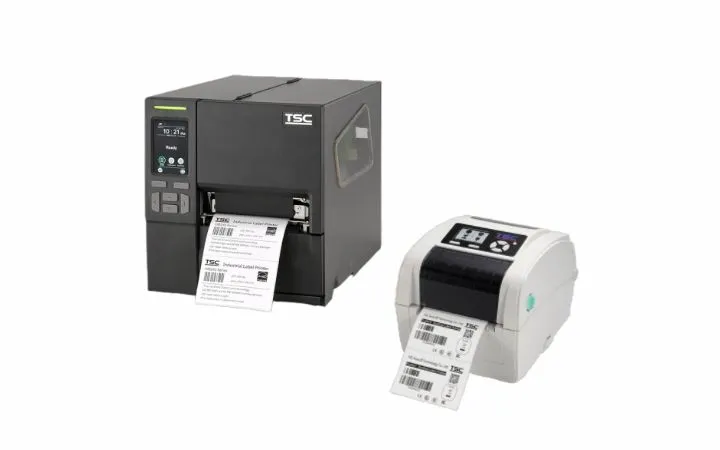
Thermal printers
Wherever variable data needs to be printed quickly on a label on-demand, this is the ideal area of application for a thermal printer. The completely uncomplicated printing options, simple operation and relatively simple technology make the thermal transfer printers from labelprint24 an indispensable aid in warehousing, sales and logistics.
Our extensive range includes everything from compact desktop printers perfect for office use to barcode printers and high-performance industrial printers designed for industrial labeling applications.
Key Features of Our Thermal Printers:
- ISO 9001 Certified: All products meet international quality standards.
- High Resolution: Achieve crisp and clear prints for all your printed labels.
Key Features of Our Thermal Printers:
Label dispenser from Labelprint24: cost-effective and convenient
Our robust manual label dispensers, made from metal or cardboard, are designed to simplify your daily labeling tasks while protecting your valuable label rolls and keeping your workplace tidy. These dispensers effectively shield your printed labels from dirt and moisture, ensuring they remain in pristine condition.
Applying labels individually to surfaces, packaging, or products can be time-consuming and impractical without the aid of manual dispensers. Here are the advantages of our manual label dispensers at a glance:
- Low Space Requirement: Compact design for effortless transport and storage.
- Multiple Label Rolls: Accommodates up to 5 different label rolls simultaneously in one device.
- Easy Handling: User-friendly operation for quick and efficient labeling.
- Flexible Functionality: Quick roll changes allow for rapid adjustments.
- Efficient Label Removal: Facilitates quick removal of labels from the liner.
- Robust Workmanship: Durable construction for long-lasting use.
Our practical desktop label dispensers enable seamless detachment and preparation of labels for removal by manually pulling the backing tape forward. Whether in a production environment, at home, on the shop counter, or at the sales stand, our manual label dispensers stick your printed sticky labels securely wherever you need them.
At Labelprint24, we offer label dispensers in various widths and designs, all at absolutely favorable prices. Enjoy first-class workmanship and long service life with our high-quality labeling accessories, including personalised labels and other printed material labels to enhance your labeling efficiency!
Manual dispenser for printed labels on rolls
Our table label dispensers allow for easy management of individual label rolls, which can be simply inserted and removed roll by roll, by hand. Designed to fit comfortably on any desk or work table, these desk label dispensers are perfect for use in office environments. Here, the dispensing speed is not the primary concern; instead, the focus is on maintaining tidiness and clean storage of your printed labels.
Using our manual labeler, the printed roll labels are advanced by pressing a lever on the handle. The individual label is transported via a rubber roller and applied to the object being labeled. While this process is relatively quick, it may still be too imprecise and slow for handling large quantities of labels.
For those in need of an efficient labeling solution, our manual dispensers and labelers successfully balance simplicity and functionality. Explore our vinyl sticker printing to find the perfect combination for your labeling needs!
Dispensing systems for printed labels on rolls
For the industrial dispensing of printed labels onto large quantities of products, automatic labeling machines are utilized. These machines come in various speed classes and are typically integrated into the manufacturer's packaging lines. A conveyor belt directs the products past the labeling machine, while light barriers ensure the products reach the optimum labeling position.
Microprocessor controls manage the printed labels, allowing for precise application on, under, or along the sides of the product packaging. Some high-speed labeling machines can apply up to 5,000 printed sticky labels per minute, optimizing efficiency in high-volume production environments. Whether you require printed material labels for shipping, logistics, or retail, our automatic labeling solutions ensure accuracy and speed.
Explore our extensive range of printed labels, including custom labels, to enhance your production line and streamline your labeling processes!

